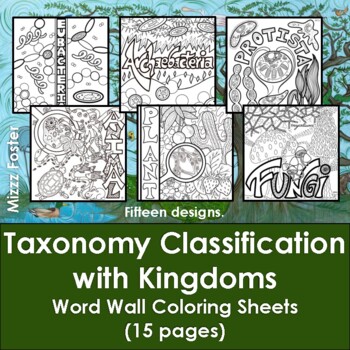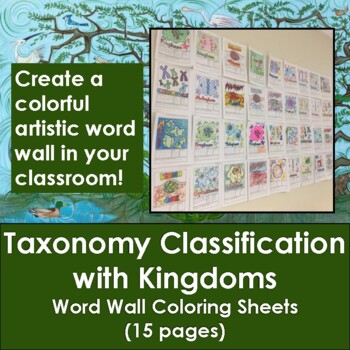Taxonomy Classification and Kingdoms Word Wall Coloring Sheets (15 pgs)
- Zip
What educators are saying
Description
This Word Wall Coloring set includes the classification words: Taxonomy, domain, kingdom, phylum, class, order, family, genus, species, Eubacteria, Archaebacteria, Plants, Animal, Fungi, and Protista.
Each word wall poster has a word wall art graphic that students can color. There is a designated box to write the scientific definitions, synonyms or examples, antonyms or non-examples, and space to write a sentence using the word.
Explore a world of scientific discovery with my hand-drawn engaging Educational Science Coloring Pages. These meticulously designed sheets are more than just coloring fun; they introduce scientific terminology in a captivating manner, making them perfect for both STEM (Science, Technology, Engineering, and Mathematics) and STEAM (Science, Technology, Engineering, Arts, and Mathematics) education. My science coloring pages are an ideal resource for students of all ages, combining creativity and learning to foster a deep understanding of scientific concepts. Dive into the world of science with our innovative coloring materials today!
Coloring pages have gained immense popularity worldwide. Explore my latest series of Science word wall coloring pages to infuse color and engagement into your middle and high school science classes.
Word Walls, initially an elementary teaching tool, has proven successful when incorporated into secondary education. My administrators encouraged its use in our classrooms, leading to remarkable outcomes. Students embraced the task of designing word wall displays, fostering pride in their contributions. This dynamic display sparked interaction as students admired each other's creations. Over time, I observed students frequently glancing at the word wall, particularly during spontaneous quizzes or warm-up exercises. The word wall bolstered their retention of vocabulary, providing a constant reference point. Not only do the word walls teach students, but they also give students a pathway to create Scientific decoration for their learning environment.
To assist students struggling with word wall activities, I developed coloring pages. While self-motivated artists can opt for a blank template, these coloring pages offer a creative outlet for those seeking guidance.
I've found word walls particularly effective post-tests, for introducing new vocabulary in a relaxed manner, as substitute assignments, and for extra credit. They also serve as an enjoyable means to revisit challenging words.
Don't hesitate to share your students' work on Instagram and tag me, @MizzzFoster.
RELATED RESOURCES:
FREE Scientific Investigation Word Wall Coloring Sheets (7 pages)





